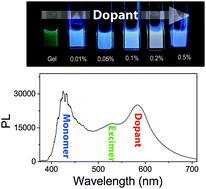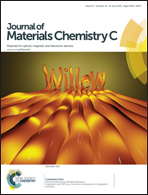Tunable emission in dye-doped truxene-based organogels through RET†
Abstract
Organic systems comprising a truxene-based organogel doped with an organic dye have been fabricated and their photophysical properties examined in the search for an organic matrix with tunable luminescent properties. The addition of the organic dopant has been observed to introduce changes in the morphology of the gel which alters the ratio between monomer and excimer species. Further, the luminescent properties of the doped organogel have been studied and their evolution with dopant concentration explained in terms of resonant energy transfer between the excimer species (acting as a donor) and the organic dopant (acceptor). The interplay between blue, green and red emission bands associated with monomers, excimers and organic dopants allows tuning the luminescence of the system within the visible region reaching white light emission under certain conditions. The origin of the energy transfer is found to be the aggregation of the molecules upon solvent evaporation, the more stable xerogel phase being the extreme case which constitutes a technologically relevant approach where solvent evaporation is not an issue.


 Please wait while we load your content...
Please wait while we load your content...